Environmental Impact Assessment of Renovated Multi-Apartment Building Using LCA Approach: Case Study from Lithuania
Abstract
1. Introduction
2. Materials and Methods
2.1. Life Cycle Assessment
- Goal and scope of the study defines the purpose and sets a boundary for the assessment;
- Life-cycle inventory (LCI) is the data collection to achieve the intended goal of the study. The process involves accounting of various input-output data related to the analysis/service which helps carry out impact assessment;
- Life-cycle impact assessment (LCIA) contains category definition, classification, characterization, and weighing as main elements with different set of procedures;
- Life-cycle interpretation is to examine the results to determine the conclusions that can be made based on the inventory results that are consistent to the goal and scope of the study.
2.2. Research Object
2.2.1. Goal and Scope
- the main building (new) materials used during the renovation of the building
- processes and energy consumption required to produce newly added construction materials during renovation
- thermal energy consumption for the heating of building premises and hot water preparation during the life cycle of the building, i.e., average heat energy consumption for 40 years
- disposal of the (old) construction materials replaced during the process of renovation (end of stage).
2.2.2. Life Cycle Inventory
2.2.3. Life Cycle Impact Analysis
- The classical impact assessment method, CML 2000 methodology is used to access and quantify the potential indicator that falls in the midpoint categories such as global warming, ozone layer depletion
- Damage related methods, such as ReCiPe, Eco indicator 99, etc., help to model the cause-effect relationship of damage and quantify the endpoint.
2.3. Energy Consumption
3. Results
3.1. Environmental Life Cycle Assessment
3.1.1. Impacts by Materials
3.1.2. Impacts by Buildings
- a non-renovated multi-apartment building
- a renovated multi-apartment (Building A)
- a modernized multi-apartment building equipped with renewable energy sources (Building B)
- about 1.14 times greater than a non-renovated building (i.e., insulation of the building’s facade walls, the ground part of the plinth, the roof and the windows);
- about 2 times higher than the environmental impact of a renovated building where renewable energy measures (Building B) used.
3.1.3. Impacts by Indicator (Single Score)
3.2. Heating Energy Consumption
4. Discussion and Conclusions
Author Contributions
Funding
Institutional Review Board Statement
Informed Consent Statement
Data Availability Statement
Acknowledgments
Conflicts of Interest
References
- A Renovation Wave for Europe—Greening Our Buildings, Creating Jobs, Improving Lives; European Commision: Brussels, Belgium, 2020.
- Filippidou, F.; Jimenez Navarro, J.P. Achieving the Cost-Effective Energy Transformation of Europe’s Buildings; Publications office of European Union: Luxembourg, 2019; ISBN 978-92-76-12394-1. [Google Scholar]
- European Commission Identifying Products With the Greatest Potential for Environmental Improvement. Available online: https://ec.europa.eu/environment/ipp/identifying.htm (accessed on 23 October 2019).
- Existing Building Energy Efficiency Renovation—International Review of Regulatory Policies; International Partnership for Energy Efficiency Cooperation: Paris, France, 2017.
- Emissions Gap Report; UNEP: Nairobi, Kenya, 2019.
- The Energy Efficiency Directive; European Commission: Brussels, Belgium, 2019.
- Vilches, A.; Garcia-Martinez, A.; Sanchez-Montañes, B. Life Cycle Assessment (LCA) of Building Refurbishment: A Literature Review. Energy Build. 2017, 135, 286–301. [Google Scholar] [CrossRef]
- Edelen, A.; Ingwersen, W. Guidance on Data Quality Assessment for Life Cycle Inventory Data; U.S. Environmental Protection Agency: Washington, DC, USA, 2016.
- Blom, I.; Itard, L.; Meijer, A. Environmental Impact of Building-Related and User-Related Energy Consumption in Dwellings. Build. Environ. 2011, 46, 1657–1669. [Google Scholar] [CrossRef]
- Cabeza, L.F.; Rincón, L.; Vilariño, V.; Pérez, G.; Castell, A. Life Cycle Assessment (LCA) and Life Cycle Energy Analysis (LCEA) of Buildings and the Building Sector: A Review. Renew. Sustain. Energy Rev. 2014, 29, 394–416. [Google Scholar] [CrossRef]
- Perednis, E.; Valančius, R.; Černeckienė, J.; Stasiuliene, L.; Vaičiūnas, J. Analysis of the Criteria for Selecting Heating Systems for Residential Buildings in Cold Climate. J. Sustain. Archit. Civ. Eng. 2018, 23. [Google Scholar] [CrossRef]
- Norvaišienė, R.; Karbauskaitė, J.; Bruzgevičius, P. Energy Performance Certification in Lithuanian Building Sector. In Proceedings of the 40th IAHS World Congress on Housing—Sustainable Housing Construction, Madeira, Portugal, 16–19 December 2014. [Google Scholar]
- Ramírez-Villegas, R.; Eriksson, O.; Olofsson, T. Life Cycle Assessment of Building Renovation Measures—Trade-off between Building Materials and Energy. Energies 2019, 12, 344. [Google Scholar] [CrossRef]
- Lidberg, T.; Olofsson, T.; Trygg, L. System Impact of Energy Efficient Building Refurbishment within a District Heated Region. Energy 2016, 106, 45–53. [Google Scholar] [CrossRef]
- Dahlstrøm, O.; Sørnes, K.; Eriksen, S.T.; Hertwich, E.G. Life Cycle Assessment of a Single-Family Residence Built to Either Conventional- or Passive House Standard. Energy Build. 2012, 54, 470–479. [Google Scholar] [CrossRef]
- Kuusk, K.; Kalamees, T.; Link, S.; Ilomets, S.; Mikola, A. Case Study Analysis of Concrete Large-Panel Apartment Building at Pre and Post Low-Budget Energy Renovation. J. Civ. Eng. Manag. 2017, 23, 67–75. [Google Scholar] [CrossRef]
- Ketomäki, J.; Pinto-Seppä, I. Overview About Nordic Residential Building Stock for Renovation—Active Roofs and Facades in Sustainable Renovation; VTT Technical Research Center: Espoo, Finland, 2015; p. 55. [Google Scholar]
- Motuzienė, V.; Gediminas, V. Environmental Performance of Energy Efficient Residential Building—A Case Study of Lithuania. In Proceedings of the Sustainable Building Conference, Graz, Austria, 26–28 September 2013. [Google Scholar]
- Moran, P.; O’Connell, J.; Goggins, J. Sustainable Energy Efficiency Retrofits as Residenial Buildings Move towards Nearly Zero Energy Building (NZEB) Standards. Energy Build. 2020, 211, 109816. [Google Scholar] [CrossRef]
- Biekša, D.; Šiupšinskas, G.; Martinaitis, V. Energy Efficiency Challenges in Multi-Apartment Building Renovation in Lithuania/Iššūkiai Energijos Vartojimo Efektyvumui Vykdant Daugiabučių Namų Modernizaciją Lietuvoje. J. Civ. Eng. Manag. 2011, 17, 467–475. [Google Scholar] [CrossRef]
- Finnveden, G.; Hauschild, M.Z.; Ekvall, T.; Guinée, J.; Heijungs, R.; Hellweg, S.; Koehler, A.; Pennington, D.; Suh, S. Recent Developments in Life Cycle Assessment. J. Environ. Manag. 2009, 91, 1–21. [Google Scholar] [CrossRef] [PubMed]
- International Organization for Standardization. ISO (2006a) Environmental Management—Life Cycle Assessment—Principles and Framework. Available online: https://archive.org/details/gov.in.is.iso.14040.2006/page/n25/mode/2up (accessed on 29 January 2019).
- International Organization for Standardization. ISO (2006b) Environmental Management—Life Cycle Assessment—Requirements and Guidelines. Available online: https://archive.org/details/gov.in.is.iso.14044.2006/page/n3/mode/2up (accessed on 29 January 2019).
- Hauschild, M.; Ralph, K.; Rosenbaum, S.O. (Eds.) Life Cycle Assessment—Theory and Practice, 1st ed.; Springer International Publishing: Berlin, Germany, 2018; ISBN 978-3-319-56475-3. [Google Scholar]
- Chau, C.K.; Leung, T.M.; Ng, W.Y. A Review on Life Cycle Assessment, Life Cycle Energy Assessment and Life Cycle Carbon Emissions Assessment on Buildings. Appl. Energy 2015, 143, 395–413. [Google Scholar] [CrossRef]
- Jeswani, H.K.; Azapagic, A.; Schepelmann, P.; Ritthoff, M. Options for Broadening and Deepening the LCA Approaches. J. Clean. Prod. 2010, 18, 120–127. [Google Scholar] [CrossRef]
- Abd Rashid, A.F.; Yusoff, S. A Review of Life Cycle Assessment Method for Building Industry. Renew. Sustain. Energy Rev. 2015, 45, 244–248. [Google Scholar] [CrossRef]
- Wernet, G.; Bauer, C.; Steubing, B.; Reinhard, J.; Moreno-Ruiz, E.; Weidema, B. The Ecoinvent Database Version 3 (Part I): Overview and Methodology. Int. J. Life Cycle Assess. 2016, 9, 1218–1230. [Google Scholar] [CrossRef]
- SimaPro-LCA Software for Fact-Based Sustainability. Available online: https://simapro.com/ (accessed on 21 November 2020).
- UAB Statybos Birža. Apartment Renovation Building. Available online: https://statybukonkursai.lt/lt/constructions/21564 (accessed on 1 August 2019).
- Citherlet, S.; Defaux, T. Energy and Environmental Comparison of Three Variants of a Family House during Its Whole Life Span. Build. Environ. 2007, 42, 591–598. [Google Scholar] [CrossRef]
- Ortiz-Rodriguez, O.; Castells, F.; Sonnemann, G. Environmental Impact of the Construction and Use of a House: Assessment of Building Materials and Electricity End-Uses in a Residential Area of the Province of Norte de Santander, Colombia. Ing. Univ. 2012, 16, 147–161. [Google Scholar]
- Ali, A.A.M.M.; Negm, A.M.; Bady, M.F.; Ibrahim, M.G.E. Environmental Life Cycle Assessment of a Residential Building in Egypt: A Case Study. Procedia Technol. 2015, 19, 349–356. [Google Scholar] [CrossRef]
- Emami, N.; Marteinsson, B.; Heinonen, J. Environmental Impact Assessment of a School Building in Iceland Using LCA-Including the Effect of Long Distance Transport of Materials. Buildings 2016, 6, 46. [Google Scholar] [CrossRef]
- Emami, N.; Heinonen, J.; Marteinsson, B.; Säynäjoki, A.; Junnonen, J.-M.; Laine, J.; Junnila, S. A Life Cycle Assessment of Two Residential Buildings Using Two Different LCA Database-Software Combinations: Recognizing Uniformities and Inconsistencies. Buildings 2019, 9, 20. [Google Scholar] [CrossRef]
- Jolliet, O.; Margni, M.; Charles, R.; Humbert, S.; Payet, J.; Rebitzer, G.; Rosenbaum, R. IMPACT 2002+: A New Life Cycle Impact Assessment Methodology. Int. J. Life Cycle Assess. 2003, 8, 324. [Google Scholar] [CrossRef]
- Peuportier, B.L.P. Life Cycle Assessment Applied to the Comparative Evaluation of Single Family Houses in the French Context. Energy Build. 2001, 33, 443–450. [Google Scholar] [CrossRef]
- Blengini, G.A. Life Cycle of Buildings, Demolition and Recycling Potential: A Case Study in Turin, Italy. Build. Environ. 2009, 44, 319–330. [Google Scholar] [CrossRef]
- Nemry, F.; Uihlein, A.; Colodel, C.M.; Wetzel, C.; Braune, A.; Wittstock, B.; Hasan, I.; Kreißig, J.; Gallon, N.; Niemeier, S.; et al. Options to Reduce the Environmental Impacts of Residential Buildings in the European Union—Potential and Costs. Energy Build. 2010, 42, 976–984. [Google Scholar] [CrossRef]
- Islam, H.; Jollands, M.; Setunge, S. Life Cycle Assessment of Residential Buildings: Sustainable Material Options in Wall Assemblies. In Proceedings of the Chemeca 2010: Engineering at the Edge, Adelaide, Australia, 26–29 September 2010; pp. 3443–3452. [Google Scholar]
- CML Department of Industrial Ecology. CML_IA Characterisation Factors. Available online: https://www.universiteitleiden.nl/en/research/research-output/science/cml-ia-characterisation-factors (accessed on 8 May 2018).
- Mateus, R.; Bragança, L. Life-Cycle Assessment of Residential Buildings. In Proceedings of the COST Action C25 Final Conference, Innsbruck, Austria, 3–5 February 2011. [Google Scholar]
- Rossi, B.; Marique, A.-F.; Glaumann, M.; Reiter, S. Life-Cycle Assessment of Residential Buildings in Three Different European Locations, Basic Tool. Build. Environ. 2012, 51, 395–401. [Google Scholar] [CrossRef]
- Bastos, J.; Batterman, S.A.; Freire, F. Life-Cycle Energy and Greenhouse Gas Analysis of Three Building Types in a Residential Area in Lisbon. Energy Build. 2014, 69, 344–353. [Google Scholar] [CrossRef]
- Official Statistics Portal Database of Indicators. Available online: https://osp.stat.gov.lt/statistiniu-rodikliu-analize#/ (accessed on 29 September 2020).
- Chow, T.-T.; Ji, J. Environmental Life-Cycle Analysis of Hybrid Solar Photovoltaic/Thermal Systems for Use in Hong Kong. Int. J. Photoenergy 2012, 2012, 101968. [Google Scholar] [CrossRef]
- Soares, W.M.; Athayde, D.D.; Nunes, E.H.M. LCA Study of Photovoltaic Systems Based on Different Technologies. Int. J. Green Energy 2018, 15, 577–583. [Google Scholar] [CrossRef]
- Speight, J.G. Production, properties and environmental impact of hydrocarbon fuel conversion. In Advances in Clean Hydrocarbon Fuel Processing; Khan, M.R., Ed.; Woodhead Publishing: Sawston, UK, 2011; pp. 54–82. ISBN 978-1-84569-727-3. [Google Scholar]
- Milousi, M.; Souliotis, M.; Arampatzis, G.; Papaefthimiou, S. Evaluating the Environmental Performance of Solar Energy Systems Through a Combined Life Cycle Assessment and Cost Analysis. Sustainability 2019, 11, 2539. [Google Scholar] [CrossRef]
- Miliute-Plepiene, J.; Staniškis, J. Analysis and Possibilities for Improving the Lithuanian Construction and Demolition Waste Management System. Environ. Res. Eng. Manag. 2006, 2, 42–52. [Google Scholar]
- Serrano-Jiménez, A.; Femenías, P.; Thuvander, L.; Barrios-Padura, Á. A Multi-Criteria Decision Support Method towards Selecting Feasible and Sustainable Housing Renovation Strategies. J. Clean. Prod. 2021, 278, 123588. [Google Scholar] [CrossRef]
- Battisti, R.; Corrado, A. Environmental Assessment of Solar Thermal Collectors with Integrated Water Storage. J. Clean. Prod. 2005, 13, 1295–1300. [Google Scholar] [CrossRef]
- Kauko, H.; Alonso, M.J.; Stavset, O.; Claussen, I.C. Case Study on Residential Building Renovation and Its Impact on the Energy Use and Thermal Comfort. Energy Procedia 2014, 58, 160–165. [Google Scholar] [CrossRef]
- Kuusk, K.; Kalamees, T.; Maivel, M. Cost Effectiveness of Energy Performance Improvements in Estonian Brick Apartment Buildings. Energy Build. 2014, 77, 313–322. [Google Scholar] [CrossRef]
- Du, L.; Leivo, V.; Prasauskas, T.; Täubel, M.; Martuzevicius, D.; Haverinen-Shaughnessy, U. Effects of Energy Retrofits on Indoor Air Quality in Multifamily Buildings. Indoor Air 2019, 29, 686–697. [Google Scholar] [CrossRef] [PubMed]
- BETA-Housing Energy Efficiency Agency. Available online: http://www.betalt.lt/en (accessed on 1 November 2020).
- Lithuanian Renovation Programme with EU Funding—Horizon 2020; Lithuanian Energy Institute: Kaunas, Lithuania, 2020.
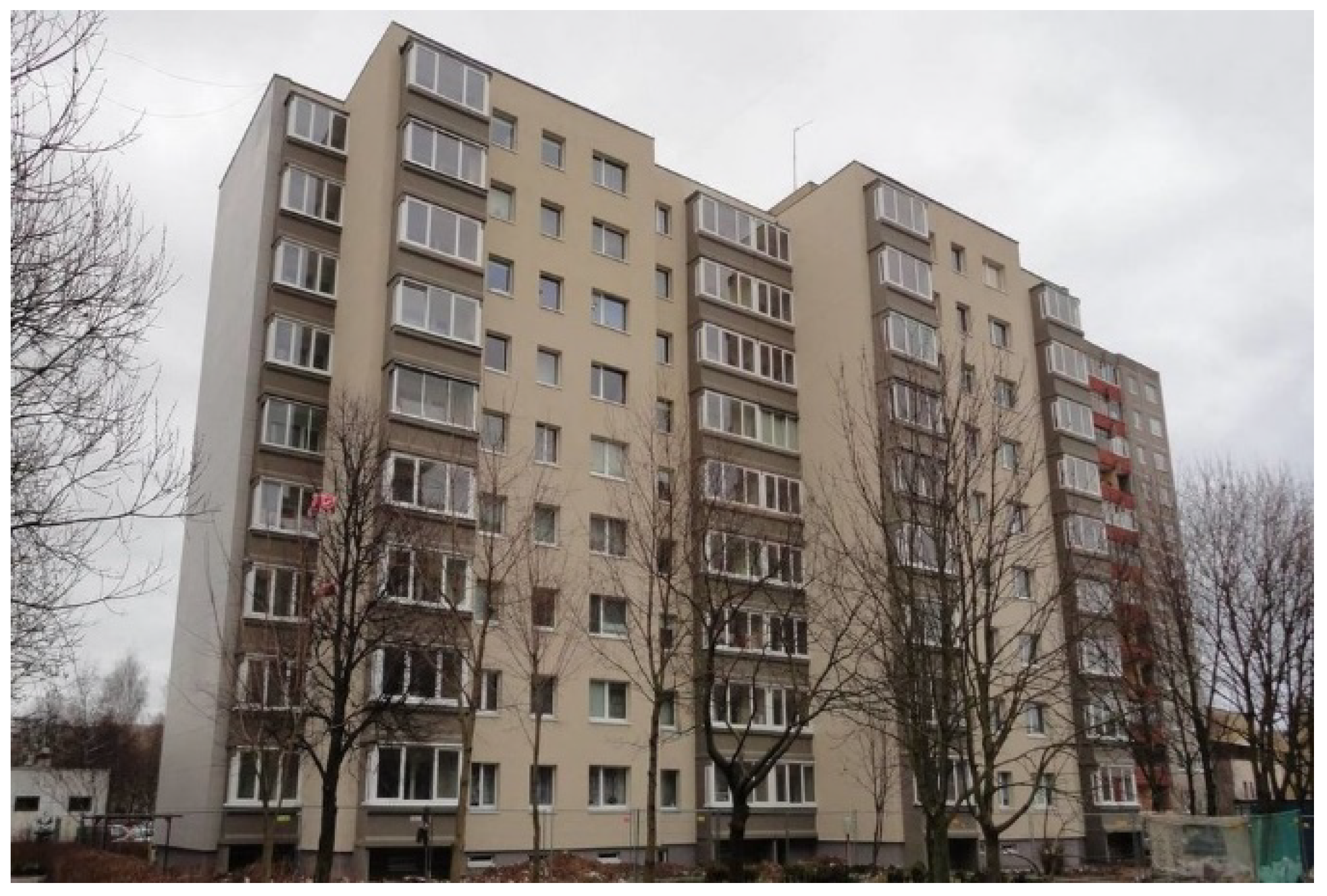
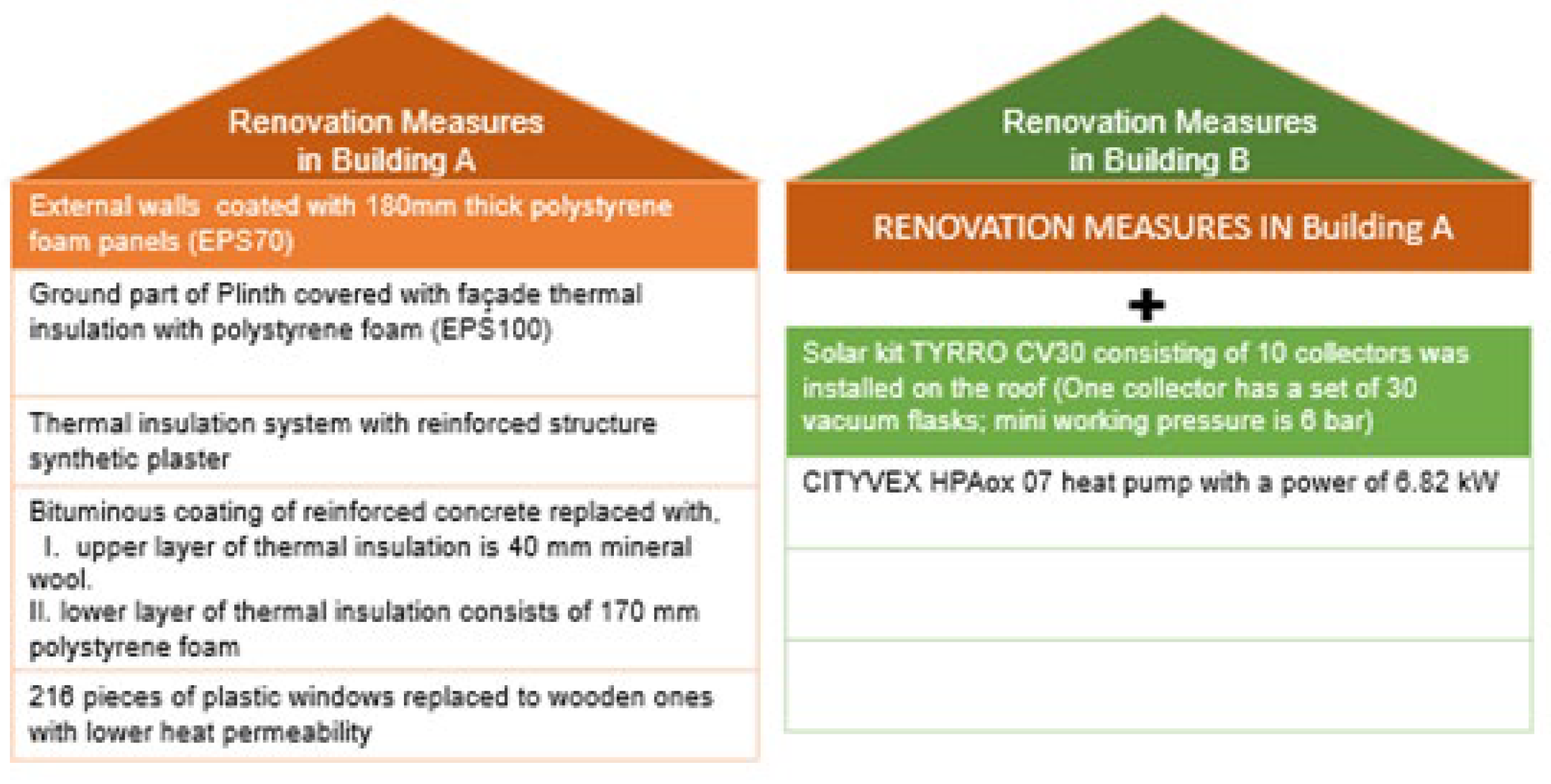
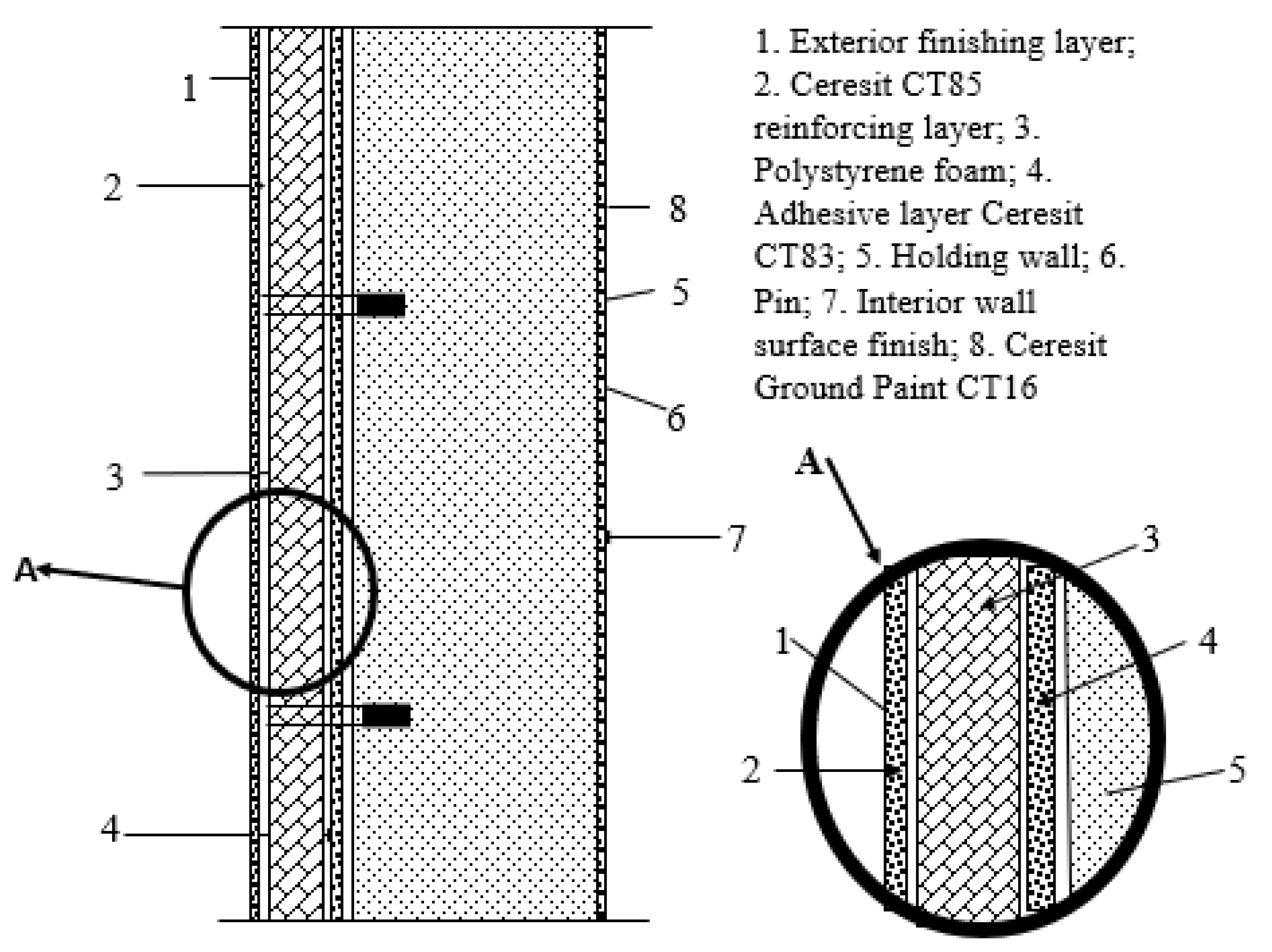
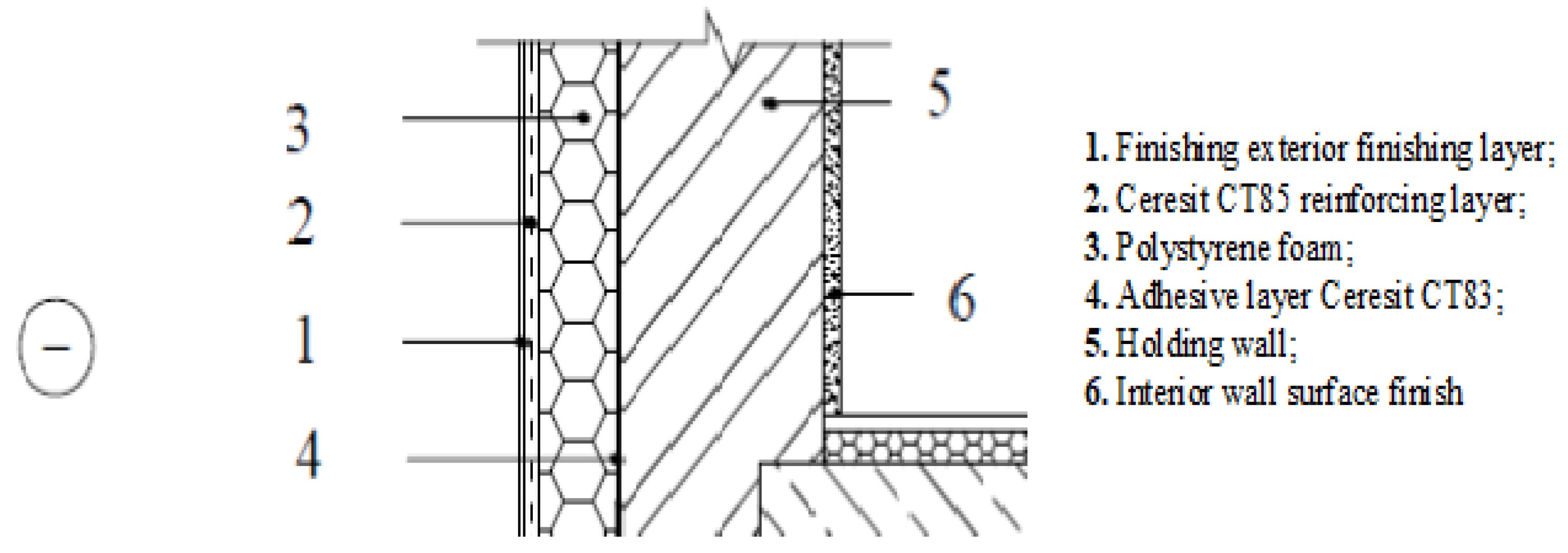

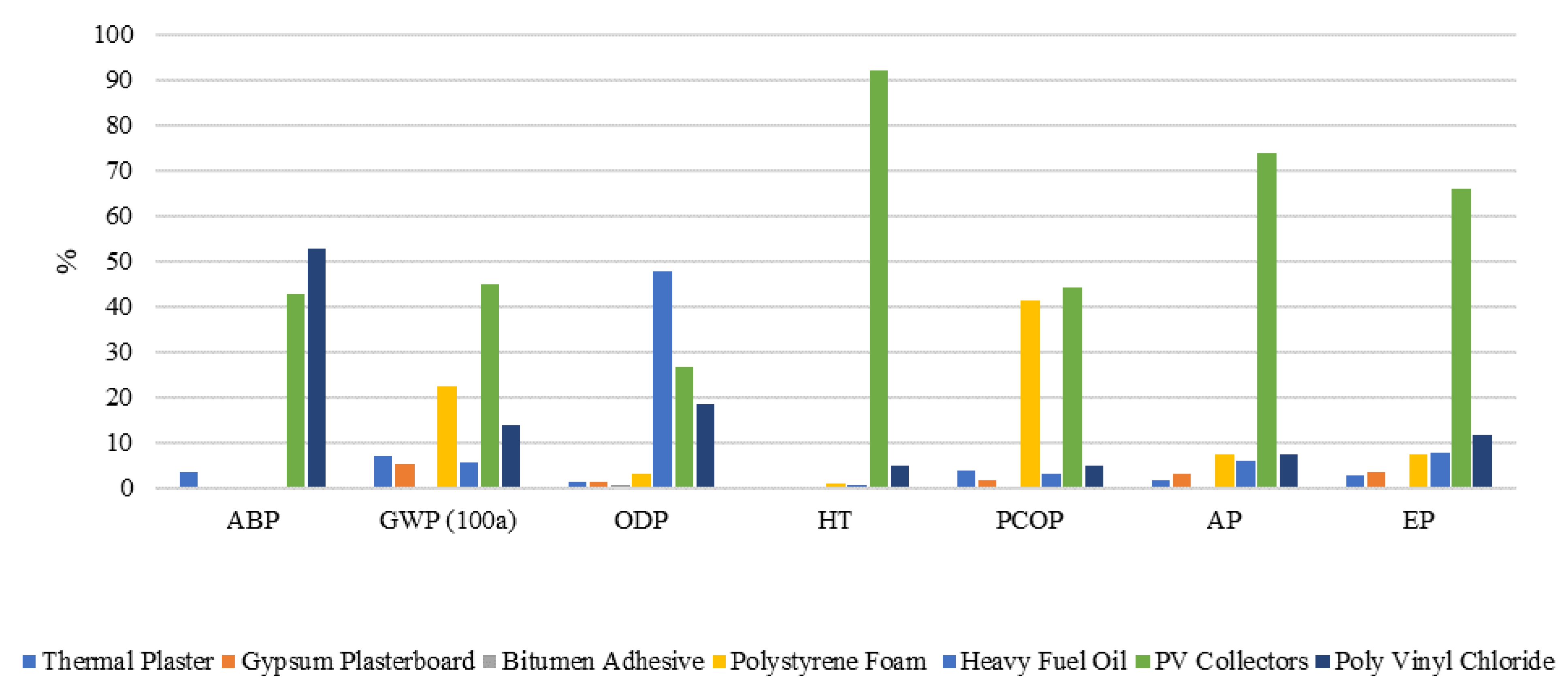
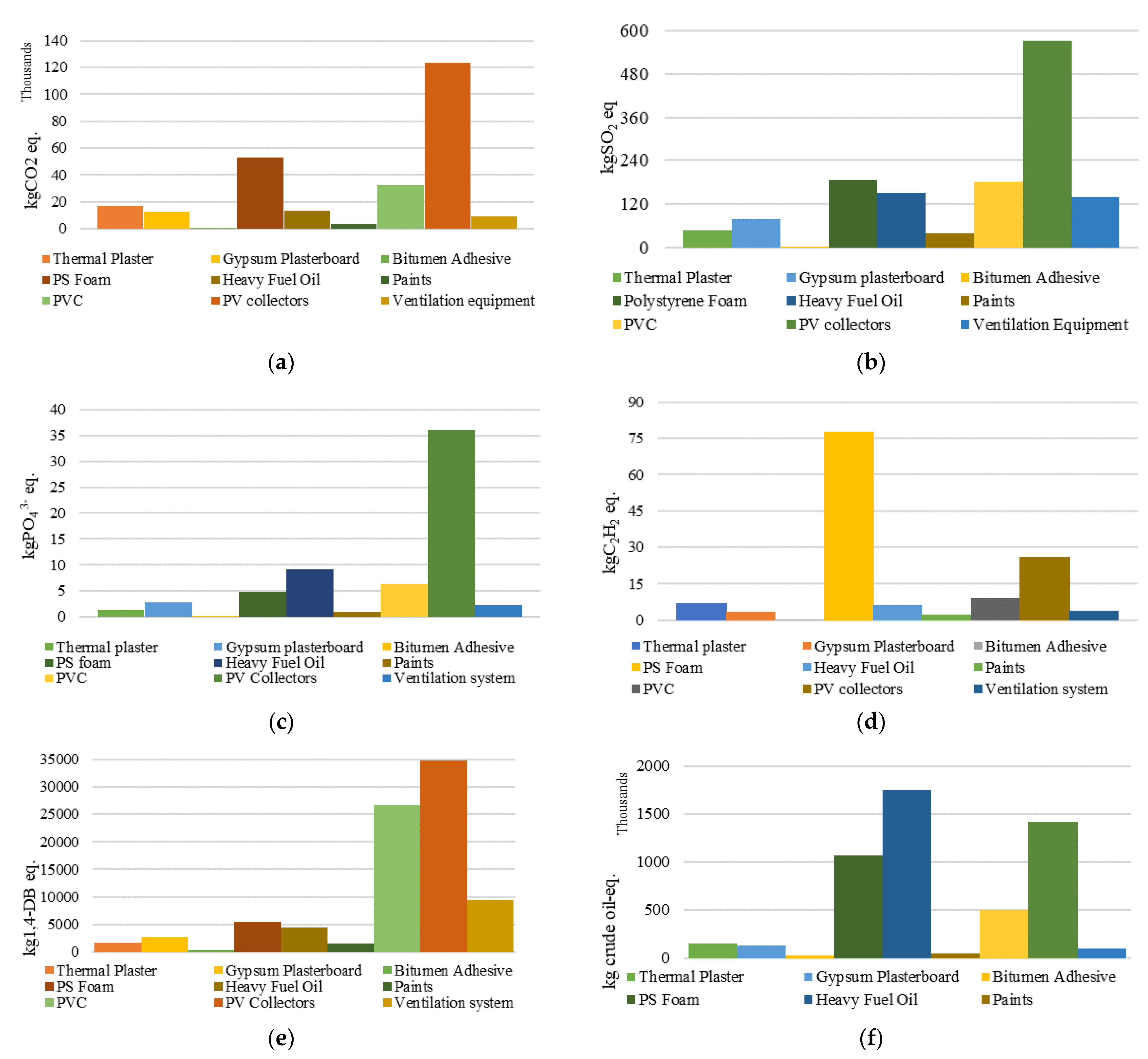
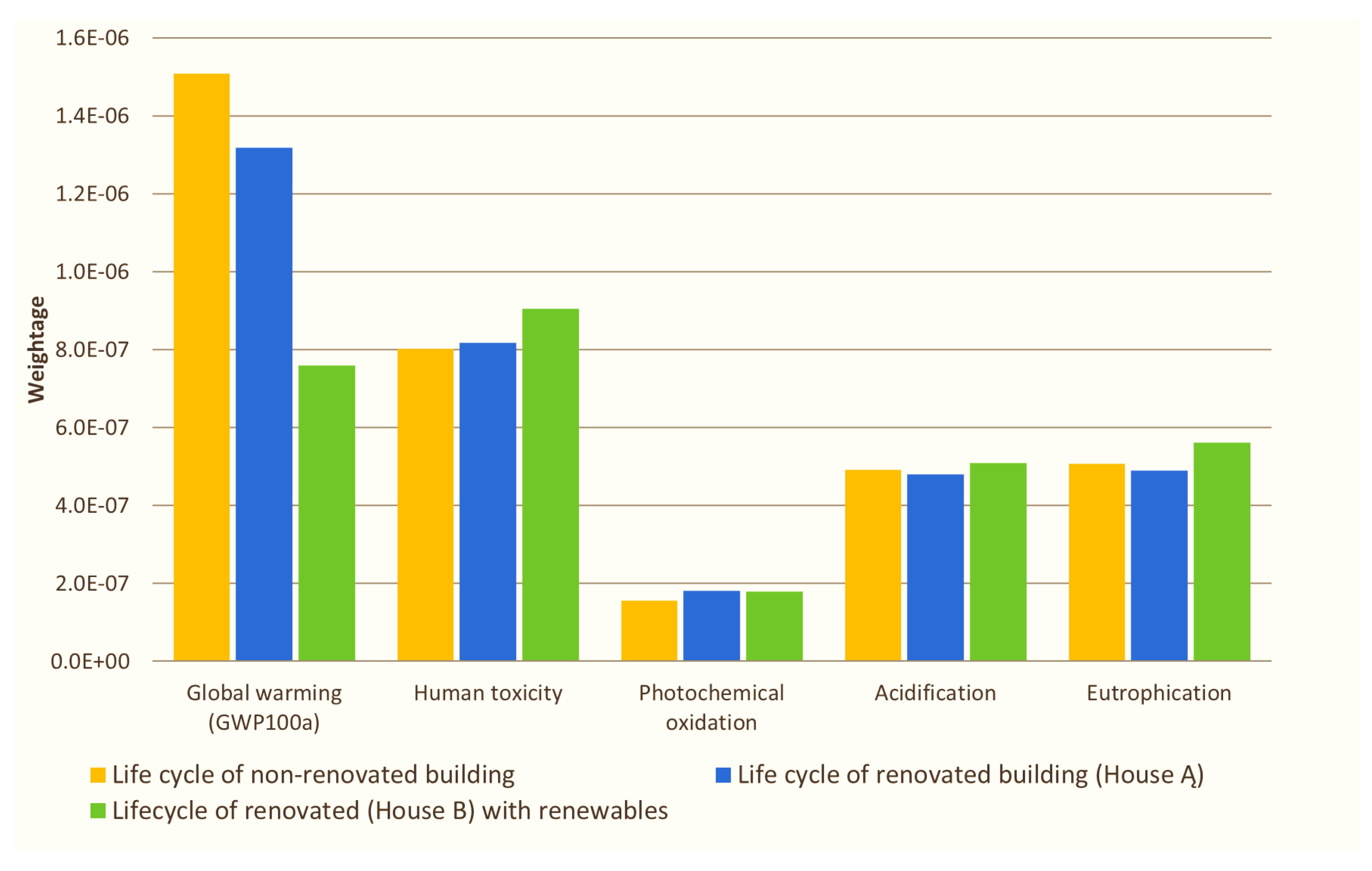
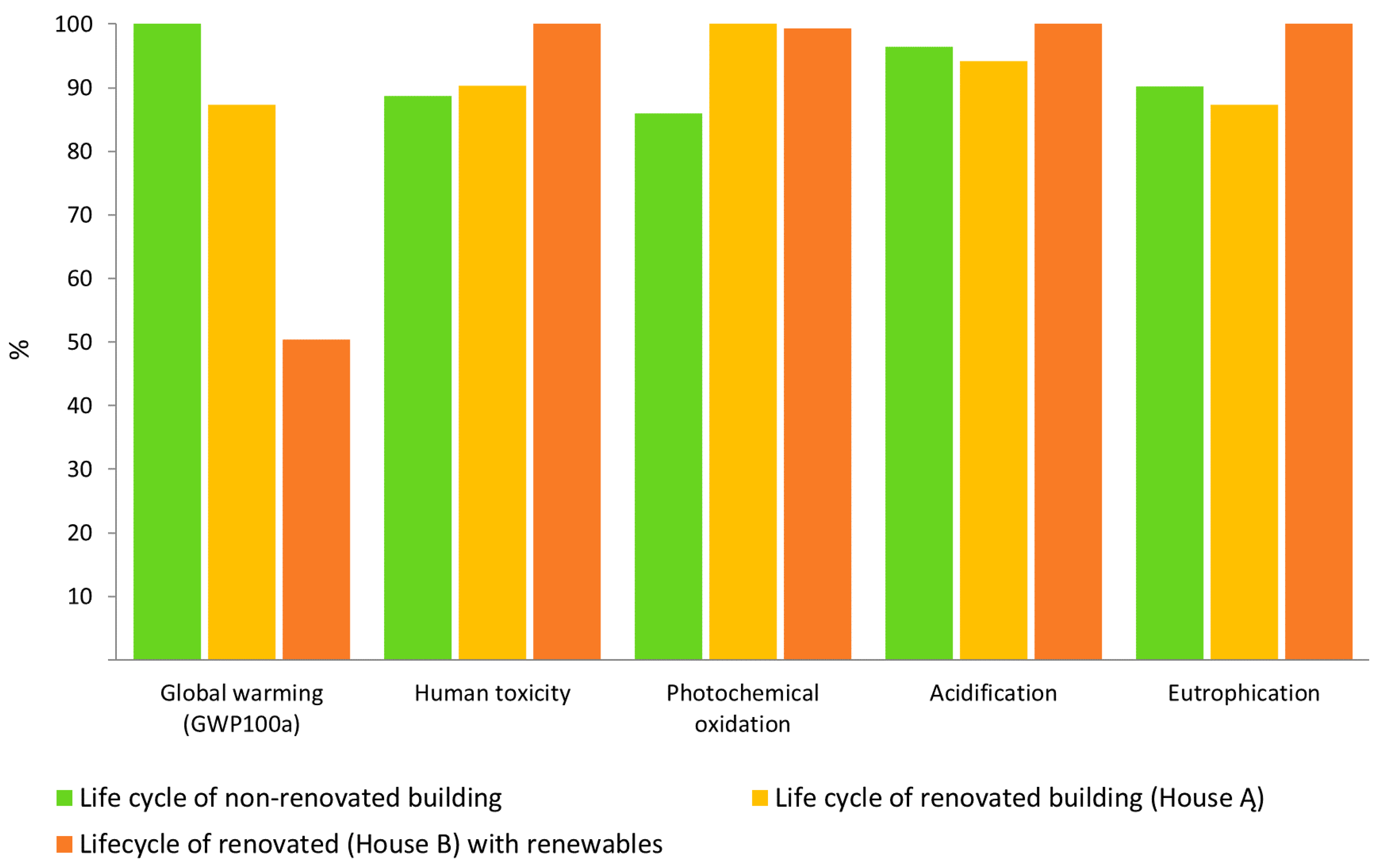
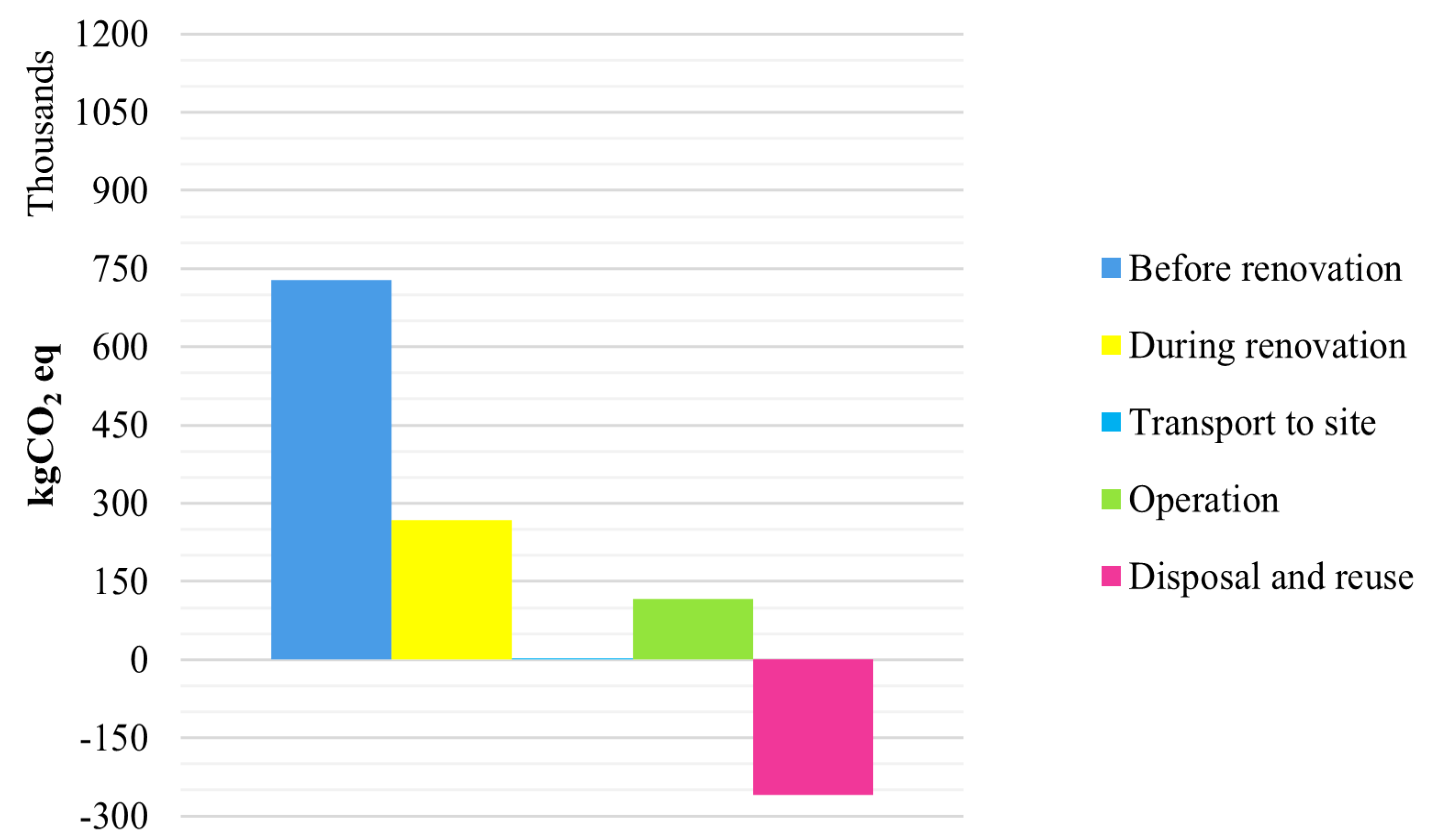
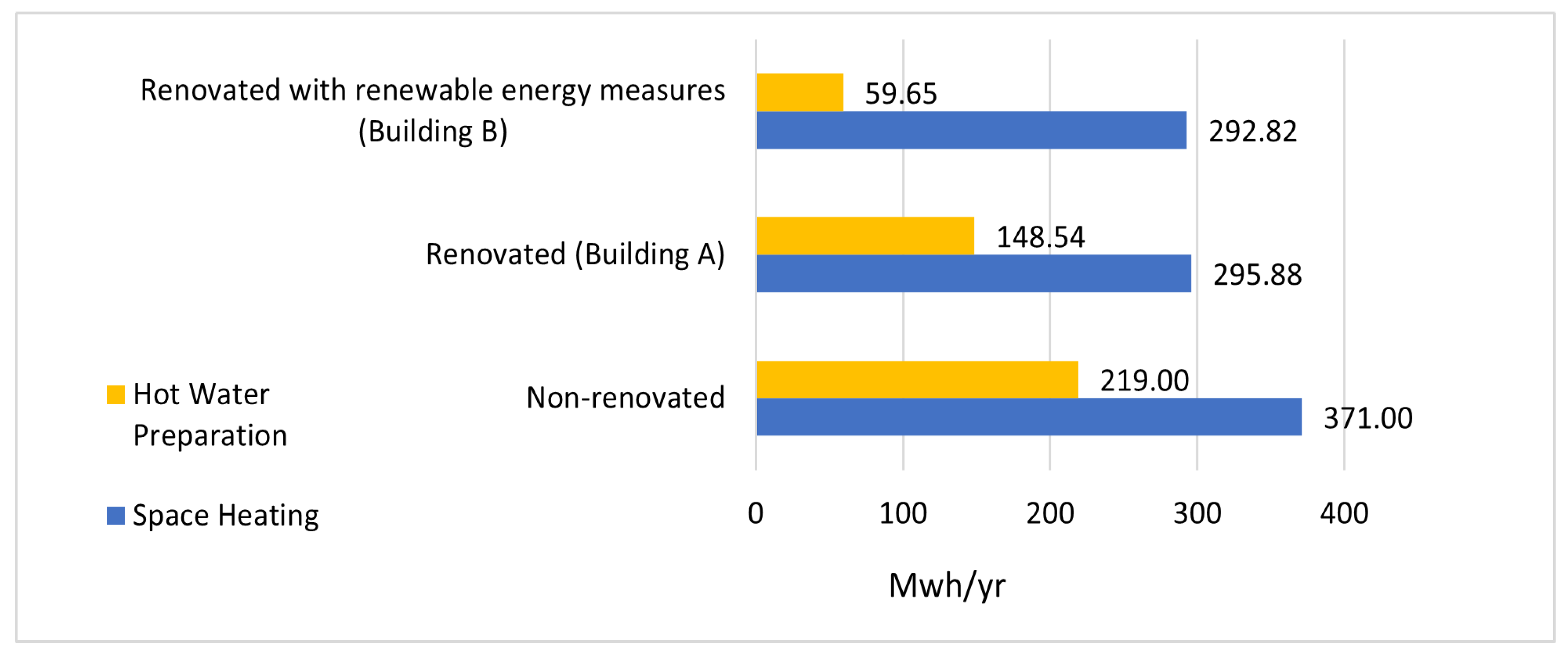
| Total Area of the Facade Walls of a House | 3658.87 m2 |
|---|---|
| Area of the ground plinth | 174.36 m2 |
| Area of the roof covered with bitumen roll | 742.90 m2 |
| Total area of the multi-storey house window and balcony doors | 112 m2 |
| Contents | Quantity | Units |
|---|---|---|
| Estimation of Building materials—Before Renovation | ||
| Concrete | 1098.16 | ton |
| Window frame(wooden) | 112 | m2 |
| Bitumen adhesive compound | 1114.35 | kg |
| Glass (density 2580 kg/m3) | 4 | m2 |
| Reinforcing Steel | 2196.65 | ton |
| Clay bricks | 13,000 | kg |
| Stone wool | 10,261 | kg |
| Paint | 3572 | kg |
| Cement cast plaster flooring | 4970 | kg |
| Polystyrene Foam | 13,179.25 | kg |
| Estimation of New Materials—Added During Renovation | ||
| Window frame (PVC) | 112 | m2 |
| Gypsum plasterboard | 32,007.47 | kg |
| Thermal plaster (outdoor) | 20,058.3 | kg |
| Glass fiber reinforced plastic, polyester resin | 38,528 | kg |
| Heat distribution equipment | 1 | p |
| Photovoltaic panel | 495 | m2 |
| Heavy fuel oil | 38,528 | kg |
| Paint | 1572 | kg |
| Transportation of materials to construction site via road (truck or carrier) | 20 | km |
| Energy for construction | 113.189 | MJ |
| Water | 109,820 | kg |
| Machine operation | 5 | hr |
| Use Stage—Before Renovation | ||
| Electricity consumption | 960.48 | Mwh |
| Water Consumption | 1750 | m3 |
| Natural Gas consumption (cooking) | 19.9 | kwh/m2 |
| Heat energy consumption for SH and HW preparation | 590 | Mwh |
| Use Stage—After Renovation | ||
| Electricity consumption | 314 | Mwh |
| Water Consumption monthly | 1750 | m3 |
| Natural Gas consumption (cooking) | 19.9 | kwh/m2 |
| Heat energy consumption for SH and HW preparation | 352.47 | Mwh |
| Heat energy consumption for SH and HW preparation (without solar panels) | 444.42 | Mwh |
| Discarded Materials (End of life) | ||
| Polystyrene | 100 | kg |
| Rockwool | 100 | kg |
| Windows (Wooden) | 7.8 | ton |
| Doors | 2 | ton |
| Glasses | 2.6 | ton |
| Steel and other (non) metals | 80 | ton |
| Other debris | 0.5 | ton |
| Transportation output of building = 30 km to disposal site after 40 years of lifespan | ||
| Disposal Scenario: Landfill = 20%, Disposal = 20%, Reuse = 60% 80% of the building materials will be recycled and the remaining will be incinerated | ||
| Environmental Impact Category | Compartment | Indicator Reference Unit | Damage Category | Method |
|---|---|---|---|---|
| Global Warming Potential (GWP) | Stratosphere | kgCO2 eq. | Climate Change | IPCC |
| Photochemical Oxidation (PCOP) | Air and land | kgC2H2 eq. | Human Health, Ecosystem Quality | CML |
| Acidification (AP) | Land and water | kgSO2 eq. | Ecosystem Quality | CML |
| Eutrophication (EP) | Land and water | kgPO4 3- eq. | Ecosystem Quality | CML |
| Human Toxicity (HT) | Ground level | kg1,4-DB eq. | Human Health | IMPACT 2002+ |
| Fossil Depletion (ABP) | Land | MJ or kg crude oil-eq. | Resources | Cumulative Energy Demand |
Publisher’s Note: MDPI stays neutral with regard to jurisdictional claims in published maps and institutional affiliations. |
© 2021 by the authors. Licensee MDPI, Basel, Switzerland. This article is an open access article distributed under the terms and conditions of the Creative Commons Attribution (CC BY) license (http://creativecommons.org/licenses/by/4.0/).
Share and Cite
Chandrasekaran, V.; Dvarioniene, J.; Vitkute, A.; Gecevicius, G. Environmental Impact Assessment of Renovated Multi-Apartment Building Using LCA Approach: Case Study from Lithuania. Sustainability 2021, 13, 1542. https://doi.org/10.3390/su13031542
Chandrasekaran V, Dvarioniene J, Vitkute A, Gecevicius G. Environmental Impact Assessment of Renovated Multi-Apartment Building Using LCA Approach: Case Study from Lithuania. Sustainability. 2021; 13(3):1542. https://doi.org/10.3390/su13031542
Chicago/Turabian StyleChandrasekaran, Vidhyalakshmi, Jolanta Dvarioniene, Ausrine Vitkute, and Giedrius Gecevicius. 2021. "Environmental Impact Assessment of Renovated Multi-Apartment Building Using LCA Approach: Case Study from Lithuania" Sustainability 13, no. 3: 1542. https://doi.org/10.3390/su13031542
APA StyleChandrasekaran, V., Dvarioniene, J., Vitkute, A., & Gecevicius, G. (2021). Environmental Impact Assessment of Renovated Multi-Apartment Building Using LCA Approach: Case Study from Lithuania. Sustainability, 13(3), 1542. https://doi.org/10.3390/su13031542







